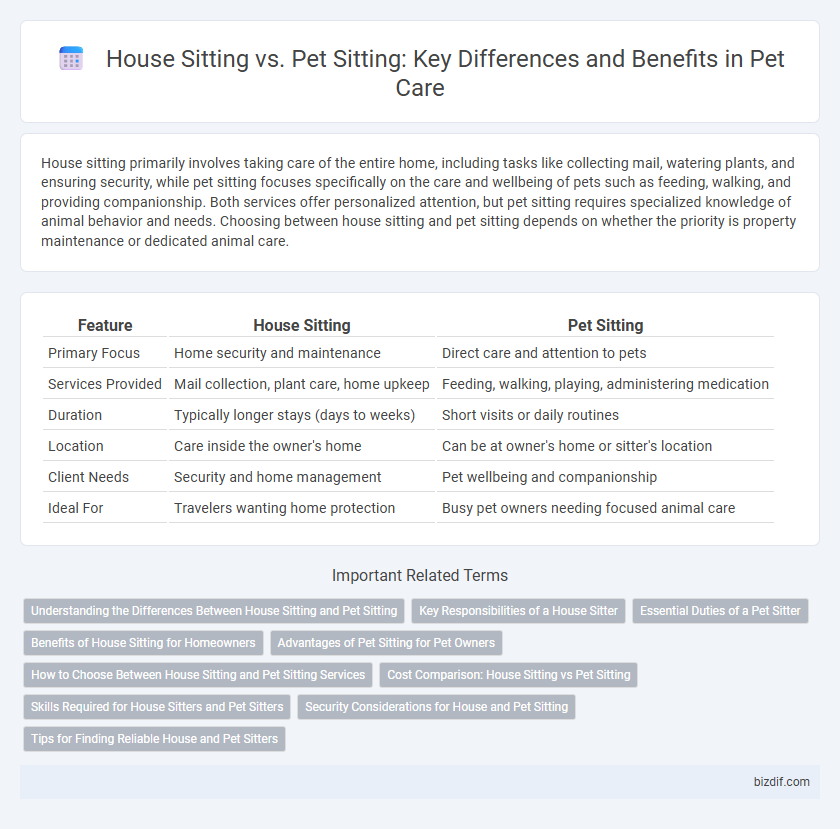House sitting primarily involves taking care of the entire home, including tasks like collecting mail, watering plants, and ensuring security, while pet sitting focuses specifically on the care and wellbeing of pets such as feeding, walking, and providing companionship. Both services offer personalized attention, but pet sitting requires specialized knowledge of animal behavior and needs. Choosing between house sitting and pet sitting depends on whether the priority is property maintenance or dedicated animal care.
Table of Comparison
| Feature | House Sitting | Pet Sitting |
|---|---|---|
| Primary Focus | Home security and maintenance | Direct care and attention to pets |
| Services Provided | Mail collection, plant care, home upkeep | Feeding, walking, playing, administering medication |
| Duration | Typically longer stays (days to weeks) | Short visits or daily routines |
| Location | Care inside the owner's home | Can be at owner's home or sitter's location |
| Client Needs | Security and home management | Pet wellbeing and companionship |
| Ideal For | Travelers wanting home protection | Busy pet owners needing focused animal care |
Understanding the Differences Between House Sitting and Pet Sitting
House sitting involves taking care of a homeowner's property, including basic maintenance, security, and sometimes plant care, while pet sitting specifically focuses on the care and well-being of animals such as feeding, walking, and administering medication. Pet sitting requires specialized knowledge of animal behavior and health needs that house sitting does not typically demand. Understanding these differences ensures homeowners select the appropriate service for their specific needs and provides peace of mind during their absence.
Key Responsibilities of a House Sitter
House sitters are responsible for maintaining the overall security and upkeep of the property, including tasks such as collecting mail, watering plants, and ensuring all doors and windows remain locked. They monitor the home for any signs of damage or suspicious activity, providing peace of mind to homeowners during their absence. Unlike pet sitters, house sitters may not be required to provide direct animal care but focus primarily on property management and protection.
Essential Duties of a Pet Sitter
Pet sitting primarily involves caring for an animal's daily needs, including feeding, walking, administering medication, and providing companionship, ensuring the pet's routine remains consistent and stress-free. Unlike house sitting, which focuses on general home maintenance such as security checks and plant care, pet sitting requires specialized knowledge of animal behavior and health. Professional pet sitters monitor pets closely for signs of illness or distress, offering personalized attention that supports the pet's physical and emotional well-being.
Benefits of House Sitting for Homeowners
House sitting provides homeowners with enhanced property security and maintenance during their absence, reducing the risk of burglary and damage. It ensures regular upkeep like mail collection, plant watering, and appliance monitoring, preserving the home's condition. This proactive care can lead to fewer repair costs and a smoother return after a trip.
Advantages of Pet Sitting for Pet Owners
Pet sitting offers pet owners personalized care tailored to their pet's routine, reducing stress and anxiety commonly caused by unfamiliar environments or boarding facilities. It ensures pets remain in their home, maintaining comfort and security, which is crucial for animals with special needs or anxiety disorders. Pet sitting also provides real-time updates and companionship, promoting overall well-being and peace of mind for pet owners.
How to Choose Between House Sitting and Pet Sitting Services
Choosing between house sitting and pet sitting services depends on the primary needs of the homeowner. House sitting focuses on property maintenance tasks such as mail collection, plant care, and security monitoring, while pet sitting centers on providing specialized care for pets including feeding, exercise, and companionship. Evaluating the importance of property oversight versus pet care requirements enables pet owners to select the most suitable service tailored to their specific circumstances.
Cost Comparison: House Sitting vs Pet Sitting
House sitting generally incurs lower costs than pet sitting since it often involves home maintenance without specialized animal care fees. Pet sitting services tend to be more expensive due to requirements like feeding, walking, and administering medications specific to pets. Comparing average prices, house sitting can range from $25 to $50 per day, whereas pet sitting typically costs between $45 and $75 per visit.
Skills Required for House Sitters and Pet Sitters
House sitting requires skills in home maintenance, security awareness, and property management to ensure the residence remains safe and functional during the owner's absence. Pet sitting demands expertise in animal care, including feeding, administering medication, exercising pets, and monitoring their health and behavior. Both roles benefit from strong communication skills and reliability, but pet sitters must have specialized knowledge of animal behavior and first aid.
Security Considerations for House and Pet Sitting
House sitting and pet sitting both require careful attention to security, but house sitting often demands a higher level of vigilance due to the responsibility of safeguarding the entire property. Securely managing keys, alarm systems, and access points is critical to prevent unauthorized entry and protect homeowners' possessions. Pet sitters must also ensure pets' safety by monitoring their environment for hazards and securing gates or fences to prevent escapes.
Tips for Finding Reliable House and Pet Sitters
Finding reliable house and pet sitters requires thorough research, including checking references and verifying experience with specific animal breeds or home care tasks. Utilizing platforms with verified reviews and conducting video interviews helps ensure trustworthiness and comfort with the sitter. Clear communication of expectations, emergency contacts, and detailed care instructions significantly improves the quality of service and peace of mind.
House sitting vs Pet sitting Infographic

 bizdif.com
bizdif.com